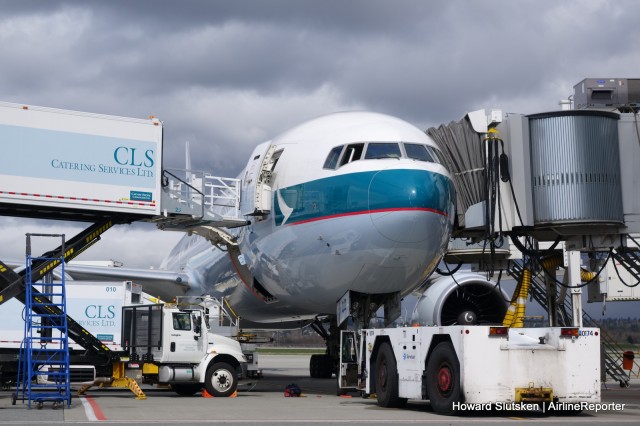
A Cathay Pacific Boeing 777-300 in the midst of a turnaround at YVR. You can see the yellow air conditioning hoses under the bridge.
Your flight has landed, and the plane is pulling up to the gate. You’re ready to spring into action as soon as you hear the “we’re stopped” chime. But instead of jumping up and waiting in the aisle, why don’t you relax in your window seat, and look outside? You do have a window seat, don’t you? There’s quite the dance of people and equipment happening, all to service the plane and get it ready for its next flight.
The turnaround actually begins long before the plane lands. Equipment is pre-positioned at the gate, supplies and catering are prepared, and ramp and terminal staff get ready for the arrival. As the flight turns onto the taxiway after landing, the crew gets their gate assignment from ground control, or in the case of a major airport, ramp control. The plane’s Auxiliary Power Unit (APU) will have been started to provide an electrical and pneumatic supply after the engines are shut down. The APU is a small jet engine, generally located in the tail cone. One of the first airliners with an APU was the tri-jet Boeing 727, and its APU was located in the wing root.
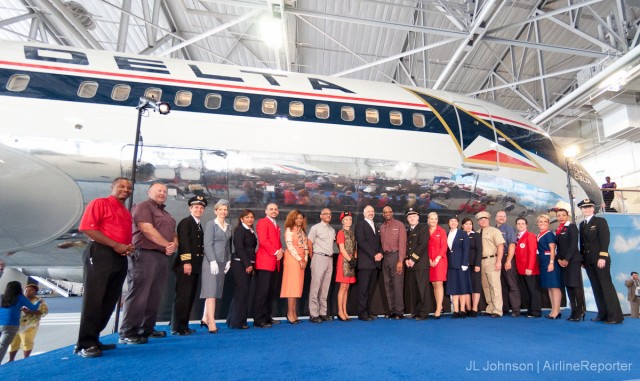
Current and retired Delta employees line up in their native uniform
A crowd gathered before a beautifully restored 767 inside a climate-controlled hangar on the outskirts of Delta’s corporate headquarters in Atlanta, Georgia. Attendees included executives, local and regional politicians, select employees, media and various VIPs. There was a marked excitement in the air. The facility had been closed to the public and shrouded in secrecy for six months, so all were excited to explore the newly renovated Delta Flight Museum.
The unveiling of the museum, which had been personally overseen by Delta CEO Richard Anderson, was timed to coincide with Delta’s 85th anniversary of passenger operations. After opening remarks by Anderson, Georgia Governor Nathan Deal and Atlanta Mayor Kasim Reed, attendees were treated to a short video illustrating Delta’s history. Following the movie and a short awards ceremony attendees were invited to enjoy the festivities and have a look around the multi-room, multi-level facility.
The museum occupies the same footprint as Delta’s original maintenance hangars which were established in the 1940s.
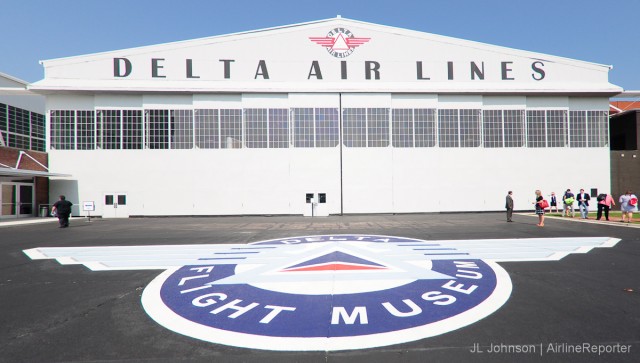
Delta Flight Museum Exterior
Visitors are assured they have indeed arrived at the right place when driving by a 757-200 restored in the “Classic Widget” livery. For extra assurance a DC-9-50 in the modern “2007 Widget” livery that sits just across the way.
BONUS: Learn more about the Delta 757-200 and DC-9 at the museum
The exterior of the facility is undeniably Delta: Bright euro-white with large block letter titling: Delta Air Lines’¦ (Air Lines; two words — they’re sensitive about that). Delta widgets adorn the pavement, the building and are strategically incorporated within the museum’s design inside and out, allowing for a sort of AvGeek easter egg hunt for those looking for a challenge.
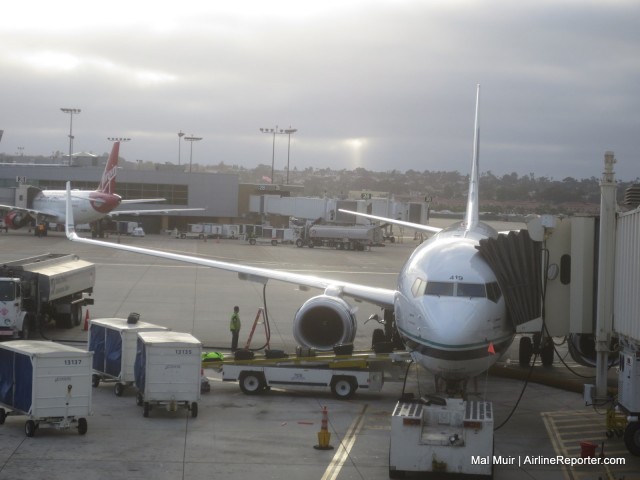
Flying non-rev on an Alaska 737-900ER….. hopefully
My real day job is a travel agent, and I have performed this job (with different companies) for the last 10 years. I have spent those 10 years planning and organizing other people’s vacations. When I make a booking for a client, it means that when they go on vacation and there is no stress for them. From the moment that they wake up on the day they leave, until the day they return, all their bookings are handled.
Being an AvGeek helps with this job, so much so that I thoroughly enjoy finding the best routing and deals for people, and I have to admit, while I spend all that time doing other people’s vacations, I can spend as much time planning my own. This planning phase to me is as much fun as going on vacation (sad, I know). So how is it that I found myself, the ultimate vacation planner, going on a weekend away with no plans?
Well, a friend of mine had access to some buddy passes and there were due to expire before the end of June. What does one do with expiring non-rev buddy passes? You use them, of course!
I had never flown on a standby ticket before. Sure, I have tried to stand by for a flight change or something similar, but never have I entered an airport for a flight without at least some form of seat for my journey. My friend told me that rather than commit to any plans for the weekend, we would pick a general destination and then as soon as we knew we had a seat on the flight, we would only then book a hotel, car, etc. I was about to become the person I dreaded the most in life — an on the fly kind of guy!
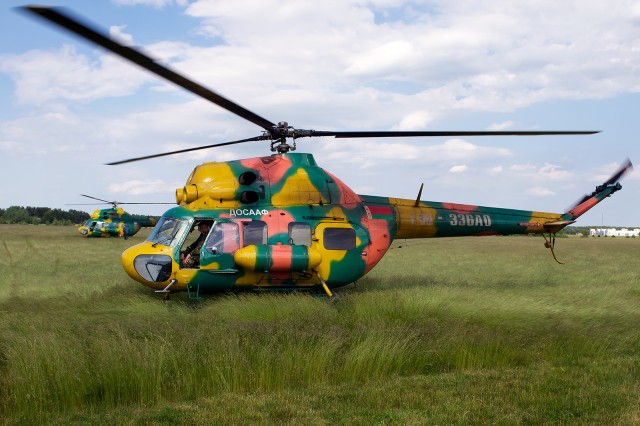
So loud, I am surprised you can’t hear them through the photo. Two DOSAAF of Belarus MI-2 await boarding Photo: Bernie Leighton | AirlineReporter
Russia was built for the helicopter, or so said Mikhail Mil. He would know, even though his cohort Igor Sikorsky beat him to the sky. Russia was also built for the Very Short Take Off and Landing (VSTOL) Biplane. There are many short, rough runways throughout Russia, previously and today, that require special aircraft.
The reason for this combined article about my afternoon with the Belorussian DOSAAF (There’s no translation, but DOSAAF is like if American ROTC units kept old equipment around to show off to civilians) is because the Antonov AN-2 and the Mil MI-2 are probably the two most instrumental and historical aircraft of post-Great Patriotic War aviation.
With scores (over 18,000) of AN-2s built and almost 6000 MI-2s- they were the ubiquitous work horses of the Soviet Union. Even stars of stage and screen!
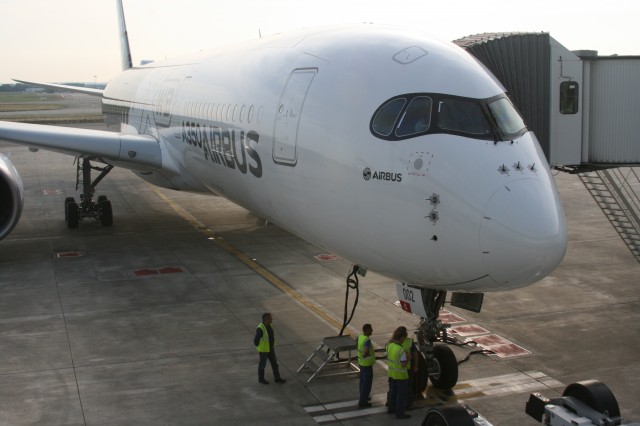
The Airbus A350 (MSN002) waiting to be boarded – Photo: Owen Zupp
A flight test program is a finely-tuned schedule, down to the most detailed demonstration, with every minute of flight time accounted for. The deadlines of certification and delivery loom ever-closer as the engineers and pilots continue to put the aircraft through its paces. Still, recently, Airbus was able to somehow wedge a 60-minute flight into their A350 XWB timeline to showcase their newest family member to a media contingent visiting Toulouse for their ‘Airbus Innovations 2014’. I was fortunate to be one of those that flew aboard that flight.
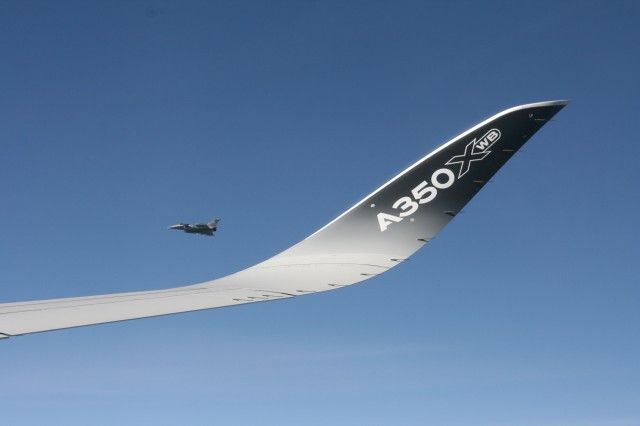
The A350 wingtip with special escort – Photo: Owen Zupp
The fact that Airbus was prepared to conduct the flight reflects two rather key points. Firstly, that their flight test program is on track and secondly, that they are confident enough in their product to take a load of media scribes aloft. Furthermore, Airbus created specific social media channels for the journalists to share the flight with the world. Consequently, there was a buzz of texting and tweeting as 200 passengers cleared a security channel and filed down the aero-bridge.
The aircraft’s cabin was still in flight test mode, so interspersed amongst the passenger seats were stations of data-gathering equipment, computer screens, and cables taped to the floor. Even so, as one walked through business class and into the economy cabin, there was still that new airplane smell. The interior boasted all of the mod-cons of inflight entertainment systems and even the fasten belt sign was a scrolling digital display. As we all settled in, there was no mistaking that this was a new generation of passenger jet and we were very privileged to take flight.






